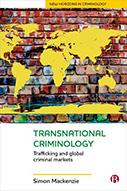Transnational Criminology: Trafficking and Global Criminal Markets

Author: Simon Mackenzie
Publisher: Bristol University Press, 2020. 173 pages.
Reviewer: Jay S. Albanese ǀ June 2022
The subtitle of this book describes its contents more accurately than does its title. In eight chapters, the book describes drug, human, wildlife, diamond, arms, and antiquities trafficking, together with an introduction and concluding chapter. Simon Mackenzie has made prior significant research contributions in several of these areas of trafficking, especially antiquities, making him an authoritative source.
The book’s introduction provides a concise summary of the scope of transnational crimes, and their distinctions from international crimes. A major contribution of the book is its application of enterprise theory in understanding transnational crime. In sum, it explains how legal and illegal businesses operate using similar methods to achieve similar objectives. The difference, of course, is that illicit markets “deal in prohibited goods, or in prohibited ways” (p. 4) with many striking similarities between legal and illegal markets and trafficking.
The author goes further in his comparisons of the licit and the illicit marketplace explaining that “traffickers thinking of trafficking as ‘just business’ is both a product of the cultures and social structures” that frame illicit trade and the compartmentalization of this important difference by the actors involved (p.12). This cross-over between the licit and illicit is often seen being carried out by the same people and businesses. As Mackenzie notes, “the antiquities dealers who sell both legal and looted artifacts, or the human trafficker who runs a travel agency arranging the international movement of persons both legally and illegally” (p. 16) illustrate an emphasis on profit linked with a willful blindness regarding method or legality.
The book’s discussion of six specific illegal trafficking markets across six chapters follows a pattern. For each topic, there is a discussion of the nature and extent of harm, the structure of the criminal market, the problems of regulation and control, followed by an application of the enterprise perspective to its existence and success. The role of the state in spurring or exploiting criminal connections to conduct and protect illicit trafficking is also explored.
An important contribution of this book lies in the concluding chapter, which endeavors to develop a social theory of trafficking across all illicit products and services. The author concludes that ”criminal trafficking is just another form of morally indifferent capitalism” (p.126). What makes it morally indifferent is ignoring the social harm caused in the pursuit of profit.
As a result, the legitimate end of the spectrum of enterprise “is depressingly similar to the illegitimate end: actors engaging in trade to chase profit without concern or compassion for adverse social effects” (p.127). In sum, the book provides useful insights into understanding distinct forms of criminal trafficking — linking them together into a larger explanation of why it occurs successfully. The book is brief, making it a useful supplement in courses on transnational crime and perhaps business courses as well.
Jay S. Albanese, Virginia Commonwealth University, Wilder School of Government & Public Affairs


